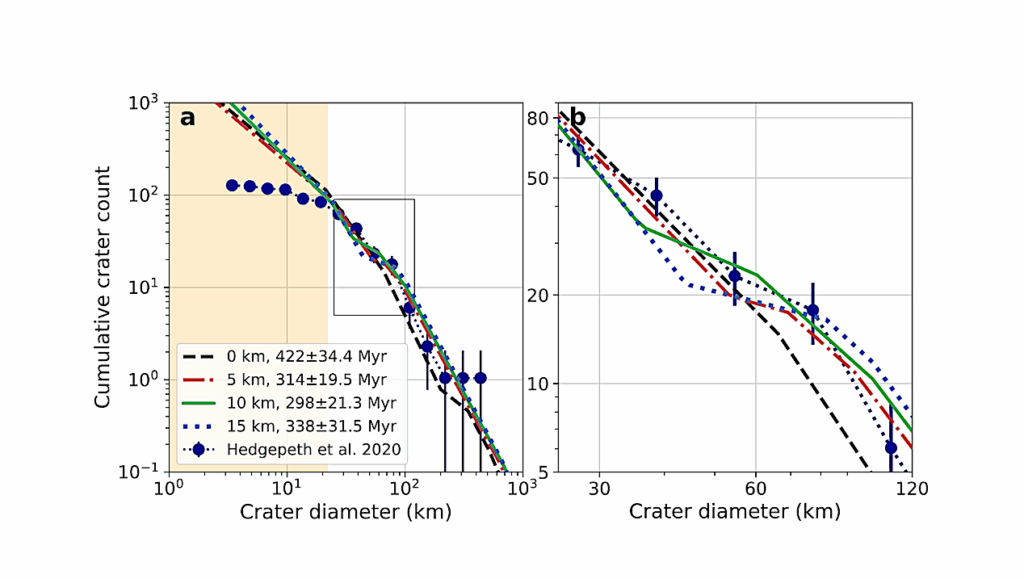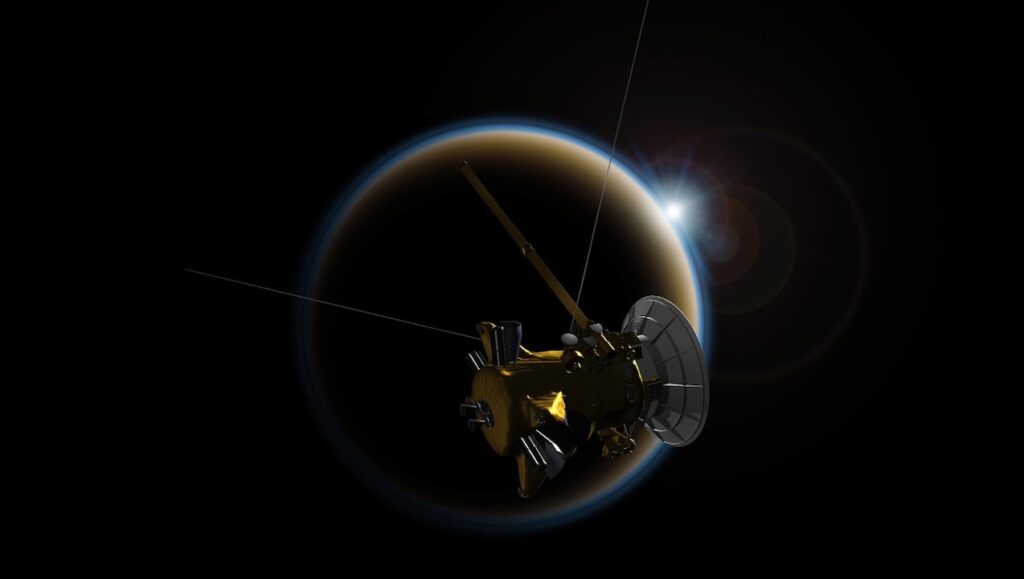The Habitability of Titan and its Ocean

Saturn’s largest moon, Titan, is a hotbed of organic molecules, harboring a soup of complex hydrocarbons similar to that thought to have existed over four billion years ago on the primordial Earth.
Titan’s surface, however, is in a deep freeze at -179 degrees Celsius (-290 degrees Fahrenheit, or 94 kelvin). Life as we know it cannot exist on the moon’s frigid surface.
Deep underground, however, is a different matter. Gravity measurements made during fly-bys by NASA’s Cassini spacecraft revealed that Titan contains an ocean beneath its ice shell, and within this ocean, conditions are potentially suitable for life.
An NAI-funded team led by researchers at NASA’s Jet Propulsion Laboratory is seeking to better understand the potential for life in Titan’s ocean, and its possible relationship with the organic molecules in the moon’s atmosphere and on its surface. Titan’s rich diversity of organic molecules is a product of ultraviolet light from the Sun initiating chemical reactions with the dominant gases in Titan’s atmosphere – hydrogen, methane and nitrogen. The resulting complex hydrocarbons could be the building blocks of life, or provide chemical nutrients for life, and within its ocean Titan harbors a potential habitat for that life.
Led by JPL’s Rosaly Lopes, the NAI team’s four key objectives are to determine how these organic molecules are transported between the atmosphere, the surface and the ocean, what processes then occur within the ocean to make it habitable, what biosignatures the ocean life then produces, and finally how those biosignatures are then transported back to the surface, where they could be detected.
Project Planning
The project, which has been funded by the NAI for five years until April 2023, is organized around the pathways that organic molecules and biosignatures take through the atmosphere and the ice shell surrounding the ocean.
The team currently has 30 members spread across a number of institutions. “Under each objective we have several investigations, and each investigation has a lead investigator,” says Lopes. Each investigation works to a schedule, so that results produced by investigations into the first objective – the transport of organic molecules – can feed into studies in the subsequent objectives.
“Our science is following the organic molecules on their path from the top of the atmosphere where they get constructed, down through the crust and into the ocean, and if there’s biology happening down there, how those organics work their way back up to the surface and become visible,” says geochemist and Deputy Principal Investigator on the project, Mike Malaska of JPL.
Objective 1: Transport
Initial science results from the project have come from Conor Nixon and his team at NASA Goddard, who have used the Atacama Large Millimeter/submillimeter Array (ALMA) in Chile to study the chemical content of Titan’s atmosphere. Knowing exactly what molecular species are found in the atmosphere allows researchers to build a comprehensive photochemical model of the atmosphere that lays the groundwork for understanding what organics are able to reach the surface and potentially enter the ocean.
Much of our knowledge of Titan’s atmosphere comes from the Cassini spacecraft, specifically the CIRS infrared spectrometer instrument. However, says Nixon, some molecular species were too faint in infrared to be detected by CIRS, but they are much brighter to ALMA. In particular, Nixon cites several cyanide molecules, CH3, C2H3CN and C2H5CN, which are key nitrogen-containing molecules in Titan’s atmosphere that ALMA was able to detect. Meanwhile, there are many more molecular species that have been detected by both Cassini and ALMA. The latter has detected spatial variations in trace organic gases created through the break up of methane and molecular nitrogen by solar ultraviolet light. As these trace gases drift through the atmosphere towards the surface, they can react with other organic molecules to form ever more complex organics. The observed spatial variation may therefore impact on the abundance and types of organics on the surface, and which organics are close to pathways into the sub-surface.
Cassini observed Titan for half a Saturnian year, from northern winter to northern summer; now that the Cassini mission has ended, ALMA will be able to observe how the atmosphere changes over the remainder of Saturn and Titan’s year – and how the abundance of organic molecules changes with it. For example, analysis of Cassini data by the NAI team has found seasonal variations in the C3Hx hydrocarbons such as propane and propyne in Titan’s stratosphere.
The remaining investigations as part of Objective 1 involve understanding how molecules are transported across the surface after they have precipitated out of the atmosphere, which is a task being led by Alex Hayes’ group at Cornell University. The next step is to understand how the organics are modified at the surface, and then how they are moved from the surface to the ocean.
This latter query has yielded a surprising possibility. One of the main results from the project so far is a paper by Kelly Miller, Hunter Waite and NAI team-member Christopher Glein of the Southwest Research Institute in Texas, which proposes that Titan’s nitrogen atmosphere originates from organic molecules that were trapped inside Titan when the moon formed, and the subsequent heating of these gases released nitrogen that seeped up to the surface. For the purpose of the NAI project, it suggests that there are already organics inside Titan that could enter into the ocean from below, so even if organics cannot reach the ocean from the surface, the ocean could still contain life’s building blocks.
“These organics may actually be able to percolate up through cryovolcanism,” says Lopes, creating a possible origin too for some of the organics on Titan’s surface.
Objective 2: Habitability
If pathways exist for organics to pass through the ice shell from the surface to the ocean below, then the next step is to figure out whether the ocean, or anywhere in the ice on the journey to the ocean, is potentially habitable. This is where the biologists on the team, studying high-pressure, cold-tolerant organisms, come into play.
Before that can be done, more needs to be known about the ocean. Although Cassini confirmed that the ocean exists via gravity measurements, “What we don’t know is the exact composition of the ocean, its density, its thermal profile, the overall structure of the icy crust on top of it,” says Malaska.
To better understand the ocean and its potentially habitability, researchers on the team start off with several possible compositions that could reasonably be expected to exist, and work backwards, developing theoretical models.
Although it may be impossible to ever directly explore the deep subsurface or ocean of Titan, the NAI team intend to use both theoretical modeling and laboratory experiments to simulate the possible conditions, to better understand the interface between the ice shell and the ocean, and the ocean with the rocky core, and the flow of oxidants and reductants at these interfaces that could support microbes.
Objective 3: Life
For life to be able to exist in or near Titan’s ocean, there must be a source of chemical energy to metabolize. Building on the work done in Objectives 1 and 2 relating to what organics reach the ocean and what the environment of the ocean is like, the team will then be able to construct theoretical models of how much energy is available in the ocean, as well as possible metabolisms that could exist in those conditions, to gauge the likelihood that life could survive there.
Assuming the ocean is habitable, with sources of chemical energy and a healthy supply of organics, the high pressure and low temperature environment may constrain the variety of lifeforms that could exist there. However, one terrestrial organism that the
team are considering as a suitable example is Pelobacter acetylenicus, which can survive on acetylene as its only source of metabolic energy and carbon.
“Our goal is to think of Pelobacter acetylenicus as the model organism, something that could exist in the deep sub-surface on Titan,” says Malaska. Laboratory experiments will be conducted, placing microbes such as Pelobacter acetylenicus in simulated environments described by the aforementioned theoretical modeling to see if the microbes can thrive in them, to learn how they adapt in order to survive, and what new types of biomolecules might result from these adaptations. These biomolecules may then leave behind biosignatures – molecular traces of life.
However, while the possible existence of life in the ocean of Titan is all well and good, we also need to be able to detect that life via biosignatures. Understanding what biomarkers life could leave is therefore the second part of Objective 3, and a database of potential biosignatures will be produced, including isotopes of carbon, nitrogen and oxygen, as well as biological structures such as the lipids in cell membranes.
Objective 4: Detection
Of course, if the biosignatures remain in the ocean, they will be impossible to detect from orbit or on the surface. Therefore, the final objective is to seek means by which those biosignatures can be transported to the surface – the inverse of the part of Objective 1 that explored ways that organics could reach the ocean from the surface.
The principal means of transport are likely to be either convective (i.e. warmer, slushy) ice rising upwards, or perhaps cryovolcanism.
“Methane in the atmosphere is destroyed by ultraviolet light, so there has to be some replenishment,” points out Lopes. “And there may still be outgassing happening.”
Although no active cryovolcanism has been detected on Titan yet, several features on the surface have been identified as potentially cryovolcanic. “We’re already studying theoretical ways that cryovolcanism can transport material,” says Lopes, in anticipation for when the results of objective 3 are available.
The transport to the surface could also create habitable environments along the way. When Mike Malaska refers to the deep subsurface, he’s not just meaning the ocean, but reservoirs that could also exist in pockets along the pathways that organic material takes in and out of the ice shell. In particular, he says, between 7 and 30 kilometers beneath the surface, at the boundary between the stiff, brittle ice and the more ductile, softer ice, where temperatures and pressures would be somewhat similar to 2 or 3 kilometers beneath Antarctica, there could exist tiny spaces in between the ice grains of the ice shell where microbes such as Pelobacter acetylenicus could thrive. Being closer to the surface than the ice shell could also mean that the resulting biomarkers from these pockets of subsurface life could reach the surface more easily.
It also raises the question of how biosignatures could be chemically altered as they rise through the pathways in the ice shell, encountering different environments – liquid water, slushy ice, and solid ice – which would then impact upon what we could expect to detect on the surface. Finally, once they do reach the surface, how will future missions to Titan detect these biomarkers? The ultimate goal of the investigation is to paint a picture of a potential biosphere on Titan, so that scientists know what to look for, and what to design instruments to detect, when we do return to Titan.
“This is our big objective, to try and evaluate Titan as a potentially habitable system,” says Malaska. “We’re going to create a list of potential biomarkers and try and indicate where on the surface might be a good place to look for them.”
Written by: Keith Cooper Source; NASA Astrobiology Institute








